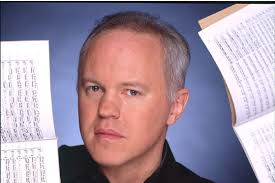 Beethoven’s Violin Concerto in D major, Op. 61 set the standard for all violin concertos which followed, but you might not have known it at the first performance on December 23, 1806. According to legend Beethoven finished writing the solo part so late that Franz Clements, the violinist who gave the premier, was forced to sight read part of the concerto in the performance. In addition, Clements may have performed one of his own pieces in between movements, playing on one string with the violin held upside down. These antics suggest that the concert experience in Beethoven’s time may have been slightly less reverential than it is today. Many listeners in 1806 may have been overwhelmed by the scale and power of Beethoven’s shocking new music.
Beethoven’s Violin Concerto in D major, Op. 61 set the standard for all violin concertos which followed, but you might not have known it at the first performance on December 23, 1806. According to legend Beethoven finished writing the solo part so late that Franz Clements, the violinist who gave the premier, was forced to sight read part of the concerto in the performance. In addition, Clements may have performed one of his own pieces in between movements, playing on one string with the violin held upside down. These antics suggest that the concert experience in Beethoven’s time may have been slightly less reverential than it is today. Many listeners in 1806 may have been overwhelmed by the scale and power of Beethoven’s shocking new music.
[typography font=”Cantarell” size=”28″ size_format=”px”]The Stern/Bernstein Recording[/typography]
Let’s listen to Isaac Stern’s great 1959 recording with Leonard Bernstein conducting the New York Philharmonic. Pay attention to the way the orchestra and the solo violin interact. This dialogue between tutti (everyone) and solo is what gives a concerto its drama. In this concerto, Beethoven often gives the violin embellishing scale and arpeggio lines which float above the melody in the orchestra. The first movement grows out of five quiet timpani notes. Listen to the way these five notes come back in different forms throughout the movement.
[ordered_list style=”decimal”]
- Allegro ma non troppo (0:00)
- Larghetto (23:44)
- Rondo (34:36)
[/ordered_list]
[button link=”https://itunes.apple.com/us/album/beethoven-violin-concerto/id261729329″]Find on iTunes[/button] [button link=”https://www.amazon.com/Beethoven-Violin-Concerto-Great-Performances/dp/B0000025M6″]Find on Amazon[/button]
The first movement is full of surprises. The five notes in the timpani provide a motivic seed, ripe for growth and development. The violins pick up this motive (0:25) but imitate it with a completely “wrong” note. Throughout the movement, Beethoven keeps us off guard, quickly alternating between moods. Just when we get lulled into lyrical complacency, we get a ferocious surprise (listen between 0:57 and 1:41). Beethoven musically provides “two sides of the same coin,” or in this case two sides of the same melody. At 1:40 the melody is sunny, in the major. Notice the way it changes to something slightly darker and more unsettling when it shifts into minor (1:55).
In the mysterious passage following 7:33 the “wrong note” is further developed. Pay attention to the way this moment of quiet musical confusion works itself out. In the tutti section which follows (8:27-10:32), the motive, which started out as five soft timpani notes in the opening, is now transformed into insistent, repeated fortissimo octaves dominated by the trumpets and horns.
Traditionally, the cadenza appears at the end of the first movement of a concerto (19:23). This is the moment when the orchestra drops out and the violinist improvises on the motives of the movement, showing off great technical skill. Later, it became common for performers to use established cadenzas. In this recording Stern plays a cadenza written by the legendary early twentieth century violinist, Fritz Kreisler.
[typography font=”Cantarell” size=”28″ size_format=”px”]Additional Links[/typography]
Here is an excellent 1989 live concert performance by violinist Kyung Wha Chung and Royal Concertgebouw Orchestra conducted by Klauss Tennstedt:
https://www.youtube.com/watch?v=2ZC4t_jCM54
In this clip Itzhak Perlman talks about his experience playing the concerto and what makes it so difficult:
[typography font=”Cantarell” size=”28″ size_format=”px”]Schnittke’s Cadenzas[/typography]
Twentieth century Russian composer Alfred Schnittke (1934-1998) wrote cadenzas for the Beethoven Concerto which offer a uniquely modern perspective. Interestingly, Schnittke not only uses the motives of the piece, but includes quotes from the Brahms, Shostakovich (First), and Alban Berg violin concertos. Schnittke also incorporates the timpani into the cadenza. Here is Gidon Kremer playing the cadenzas to the First Movement:
Schnittke’s cadenza for the third movement brings back motives from the first movement:
[typography font=”Cantarell” size=”28″ size_format=”px”]Coda[/typography]
Share your thoughts on this remarkable piece in the thread below. What was your experience listening to the cadenzas by Schnittke? Do they enrich the piece or do they seem jarringly out of place? Do you have a personal favorite recording of the Beethoven Concerto?



 In the virtual isolation of early twentieth century New England, an organist and insurance salesman named Charles Ives (1874-1954) was imagining shocking and innovative new music. Ives created atmospheric collages of sound. He poured fragments of American folk songs and other material into a musical melting pot to create an exciting cacophony. Much of his music became widely known only decades later when other composers embraced similar techniques.
In the virtual isolation of early twentieth century New England, an organist and insurance salesman named Charles Ives (1874-1954) was imagining shocking and innovative new music. Ives created atmospheric collages of sound. He poured fragments of American folk songs and other material into a musical melting pot to create an exciting cacophony. Much of his music became widely known only decades later when other composers embraced similar techniques. Today is the 100th birthday of twentieth century English composer Benjamin Britten (1913-1976). Let’s celebrate by listening to Britten’s Four Sea Interludes from the opera, Peter Grimes. Played during scene changes, these interludes express the drama of the opera’s unsettling story. As you listen, consider the mood that Britten evokes and pay attention to the orchestration. You can read the synopsis of the entire opera
Today is the 100th birthday of twentieth century English composer Benjamin Britten (1913-1976). Let’s celebrate by listening to Britten’s Four Sea Interludes from the opera, Peter Grimes. Played during scene changes, these interludes express the drama of the opera’s unsettling story. As you listen, consider the mood that Britten evokes and pay attention to the orchestration. You can read the synopsis of the entire opera  Timing is an important element in music as well as comedy. A great comedian knows how to build up to the punch line of a joke . Similarly, great composers have an intuitive understanding of proportion in music. They know how long to repeat an idea before moving on. They allow the music to unfold organically in a way that seems “right”, as if the piece is composing itself.
Timing is an important element in music as well as comedy. A great comedian knows how to build up to the punch line of a joke . Similarly, great composers have an intuitive understanding of proportion in music. They know how long to repeat an idea before moving on. They allow the music to unfold organically in a way that seems “right”, as if the piece is composing itself.